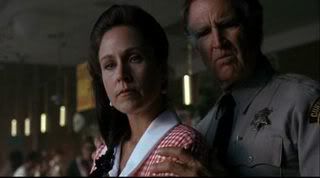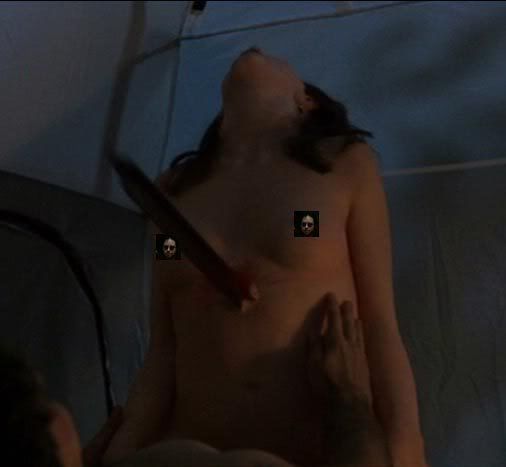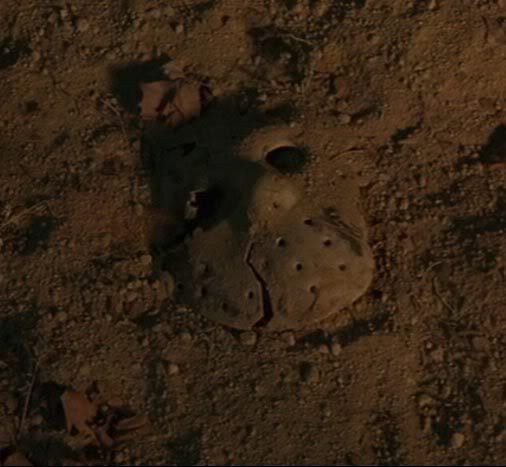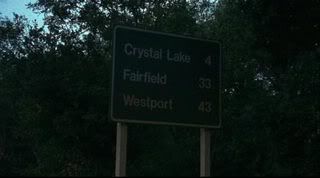
Having just recently
dipped my toes into the murky, deadly waters of Camp Crystal Lake, I thought I’d wait awhile until I indexed another installment in the
Friday the 13th series (which, for reasons I myself cannot decipher, is the only major horror franchise I own in its entirety) but then it occurred to me that having pinpointed
A New Beginning’s lack of any genuine Jason Voorhees action as its fatal flaw, it could be enlightening to talk about the film for which that exact same narrative attribute is its chief virtue.
In truth, many fans would disagree with this assessment, insisting that today’s film is just as misbegotten as A New Beginning, both for its heresies against the Crystal Lake mythology and general crappiness. One only has to look at their respective IMDb pages to appreciate this—4,745 registered users have given A New Beginning an average rating of 3.6/10, while 4,365 voters have given our present subject an average rating of 3.9/10.
This is fucked up. A New Beginning deserves a much, much, much lower score than 3.6 and today’s movie definitely deserves better than a measly 3.9, but their .3 difference in public regard serves as ample proof that often people’s expectations blind them to what they are actually seeing.
Fanboys are a fickle, impossible-to-please group of malcontents. Obsessed with re-experiencing the simple pleasures of their childhoods, they are forever doomed to disappointment as their loss of innocence and ascent into adulthood makes finding those experiences virtually impossible. In part this because on the one hand they demand that they be surprised and delighted by things they have never seen before, while also insisting that filmmakers do not deviate even one iota from their frequently-ridiculous narrow realm of expectation.
This leads to such amusingly paradoxical situations as people online spending years and years demanding that a studio commit hundreds of millions of dollars to make a live-action version of an adored cartoon from their childhood, only to react with terrible fury when a studio finally takes the bait but—CAN YOU FUCKING BELIEVE IT?—doesn’t make it EXACTLY like they imagined it should be. I’ve never actually seen the first live-action version of
Scooby-Doo, but I did find it hilarious that when it was released so many online commentators were outraged that a movie based on a TV show they had watched as children was <GASP!>
turned into a movie actually intended for children!
This is why today’s film, which is a perfectly enjoyable and adeptly made example of the slasher movie, is held in such low regard—not because of what it actually is—a fun rip-off of
The Hidden—but because of what it isn’t—all Jason, all of the time.
Of course, I’m talking about:

For a time it appeared that Jason Goes to Hell was actually going to be true to its words and in fact be The Final Friday--unlike Part IV, whose status as The Final Chapter didn't even last a year before we saw the nigh-craptaculer A New Beginning. That this is the case seems especially odd given the history of the film. Unlike the previous 8 films in the franchise, JGTH wasn't produced by Paramount Studios, which had finally decided after the lacklustre b.o. of Jason Takes Manhattan that they finally had the opporunity to do what they had always wanted and get out of the Friday the 13th business for good. But rather than just bury the series, they decided to make a quick buck and sell the rights to it to New Line, the little studio that could, which at that time was best know for its A Nightmare on Elm Street franchise, but would later become a far-more major Hollywood player as the studio behind the Lord of the Rings trilogy.
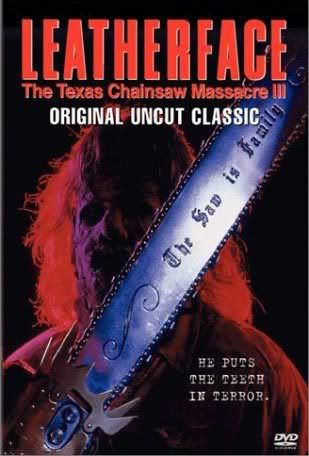
This wouldn't be the first time New Line purchased the rights to an apparently moribund horror movie franchise. In 1990 the studio had attempted to restart the inert
Texas Chainsaw Massacre franchise with
Leatherface: Texas Chainsaw Massacre III, but the film seemed to be cursed from its conception and failed to make an impact with horror fans, many of whom resented the changes the movie made to the previous film's characters and back story.
Since it's impossible to believe that the studio would buy the rights to the franchise simply to bury it, one has to assume that they dubbed it The Final Friday not because they actually believed they wouldn't continue the series if the film proved to be a hit, but because a) they figured that they might trick sentimental fans who were disappointed by the last few Paramount films into seeing it and b) they were going to rejigger the formula to such a noticeable degree that the next film in the series could reasonable be released as The New Friday. For proof of this one only has to take a look at a film they released a year after JGTH, 1994's New Nightmare, which attempted to take the apparently-concluded A Nightmare on Elm Street series into an entirely new direction.
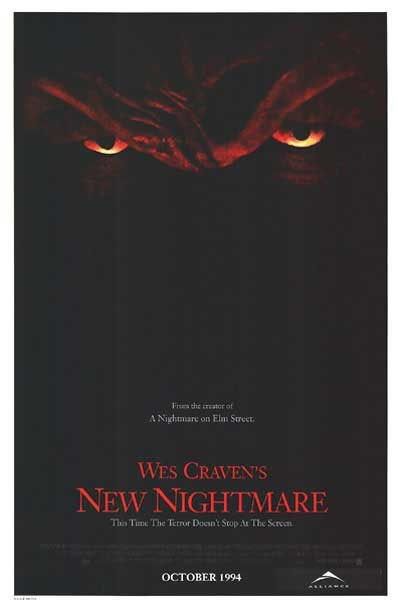
But unlike A Nightmare on Elm Street Part 6: Freddy’s Dead, which earned enough money to justify the making of New Nightmare, JGTH proved to be as much of a flop as Leatherface had been three years earlier. Rather than reinvent the franchise, which had been it’s obvious intended purpose, the ninth Friday the 13th instead did what it had advertised and stopped the series cold, forcing fans to wait 8 years before Jason Voorhees finally returned to the screen in 2001’s Jason X, which—like Jason Lives—solved the continuity problems created by its predecessor simply by ignoring them and taking the series in an entirely new direction.
However the story of JGTH doesn’t end there. Despite all of the antipathy it earned upon its release, the film was notable for including a final shot that teased a confrontation that fanboys everywhere spent a decade demanding they be able to see, only to vehemently decry the result once it was given to them and wasn’t exactly what they wanted or expected.
But enough with the backstory, let's talk about the actual movie.
In attempting to reinvent the franchise, the makers of
JGTH, decided to do something at the beginning of the film all of their predecessors insisted on leaving to the end—they killed Jason (in so far as Jason can be killed). And not only did they kill him—in the words of the exalted critics of SCTV’s fabled “Prairie Film Report”—“They blew him up real good!”
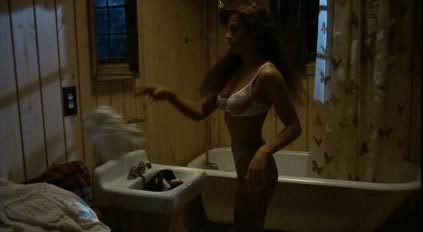
For it’s opening sequence alone the 9
th Friday the 13th deserves to be held in much higher regard than it’s spiritual peer
A New Beginning. Unlike the fifth film, which is so inept that it plays like a self-parody when it clearly isn’t,
JGTH immediately establishes a sly self-mocking tone that it carries with it throughout its entirety.
The film begins with a beautiful young brunette driving to a cabin out at the infamous Crystal Lake. Although she first appears in the overtly tomboyish clothes of a final girl, she wastes no time stepping out of them and revealing an amazingly toned body as she takes her requisite shower. But no sooner does she get out of the bathtub and cover herself with a towel then she is attacked by a machete wielding Voorhees.
Clad only in the towel (which she apparently stapled onto her body, such is its determination not to come off) she runs from the cabin and is chased by the zombified murderer throughout the forest. Despite her obvious athleticism (she easily hurdles the hood of her own car) she somehow manages to trip and fall several times before she arrives at a large clearing where Jason catches up to her and goes in for the kill. But this isn’t no ordinary clearing and no ordinary uber-hottie in a towel. As he steps towards her, a series of bright spotlights turn on and illuminate the area. A squadron of soldiers appear from behind camouflage and begin to attack the confused maniac. True to his nature, Jason is able to absorb hundreds of bullets without any seeming affect, but even he proves no match for the missile that is fired at him from a helicopter up above. Our favourite anti-hero explodes into a hundred little pieces, including his dark, black heart, which is ordered to be bagged up by the officer in charge, who also takes the time to congratulate the still-towel-clad
Agent Marcus.
Not Safe For Work!
With this, director Adam Marcus (who was only 24 when the movie was made) and his screenwriters manage to both honour, mock and seperate themselves from the cliches and necessary contrivances of the series and the genre it helped to spawn before the film's opening credits have even appeared onscreen, which then allows them to move on to what amounts to an admittedly cheesy, but still entertaining riff on a classic sci-fi/horror movie New Line released 6 years earlier.

In Jack Sholder's
The Hidden, two police officers--one human, one alien--join forces to track down a psychopathic parasite that is able to fulfill its voracious physical and monetary desires by jumping into different human hosts (including--
most memorably --a pre-
Babylon 5 Claudia Christian). In
JGTH, the evil spirit of Jason Voorhees remains alive in his evil black heart, which--after his decimation--is taken to the medical examiner who has been tasked to perform the autopsy on Jason's various remains. Unfortunately for the examiner Jason's evil is too great to be defeated for long and it compells the poor man to eat the pulsating organ, causing his body to be taken over by Voorhees' murderous psyche, which--like the parasite in the earlier movie--is able to jump into another person's body whenever the one it's currently in proves to be no longer desirable.
And this time our anti-hero actually has a mission.
Did you know that Jason Voorhees had a sister? Turns out he did and she's a dead ringer for
Wilma Deering, which suggests that the genetic material swirling around the Voorhees clan was capable of very high highs and very low lows. Strangely, no one around her seems to know this except for the mysterious bounty hunter who's offered to catch Jason for the princely sum of $250,000, which is odd since she still lives in the area around Crystal Lake and you'd think it would eventually come up in conversation:
Small Town Yokel #1: Hey, there's that Diana Kimble. She was the prettiest girl in our class.
Small Town Yokel #2: Wasn't there some fuss awhile ago involving her family?
Small Town Yokel #1: Well, there was the time everyone thought her retarded brother drowned at the lake down the road, because some teenagers were too busy fooling around to look out for him. That bothered her mother some, so she killed a bunch of kids, before she got her head chopped off, which was a shame because it turned out that the boy hadn't died, but had instead raised himself alone in the woods. He hadn't seen his mother for awhile, but he got mighty annoyed when he heard what had happened to her, so he decided to kill some kids on his own. They eventually killed him, but he rose out of the grave like one those whatchamacallits--
Small Town Yokel #2: --Zombies--
Small Town Yokel #1: --That's right. Since then he's been an unstoppable monster leaving nothing but misery and terror in his horrible wake.
Small Town Yokel #2: I guess that's why she changed her name.
Small Town Yokel #1: Actually no. She just married some fellow named Kimble. It lasted long enough for them to have a kid, who's all grown up now. Lately she's been dating the sheriff and working as a waitress at the restaurant that serves hamburgers shaped like the mask her evil zombie brother wears.
Small Town Yokel #2: The sheriff, huh? What does he think about her family?
Small Town Yokel #1: Y'know, I've never heard him bring it up.
But before this becomes too big of a plot-hole, the possessed M.E. arrives at the lake to kill some campers Jason-style, including one unlucky young woman who I think earns the title of goriest death in the series.
Judge for yourself (warning--even censored this probably ain't safe for work):
(Note: Once again use your mouse pointer to create some truly gory misogynistic mayhem)
It turns out that Jason requires the body of a fellow Voorhees to return to his full NHL ready form, which leaves him with just Diana, her grown up daughter Jessica and Jessica's newborn baby as his only options for salvation. But, luckily for the world at large, these three also have the ability--while wielding a magical dagger--to stop the black sheep of their family once and for all. Thus the majority of the movie is composed of Jason's spirit jumping around in different people's bodies doing that voodoo he do so well, the frantic attempts by the father of Jessica's baby to prove that he isn't responsible for the murders and save the woman he still loves and Jessica learning about the extreme nature of her family tree.
In short, JGTH actually has a plot, which is probably the major reason so many fans of the series have seen fit to reject it. In truth, most average viewers will finally little praiseworthy in the film, but I found it just so darn goofy and energetic that I couldn't help but like the lil' fella. It helps that I took the time to listen to the commentary by director Marcus and co-screenwriter Dean Lorey, which is one of the more honest and entertaining audio track discussions I've had the pleasure of hearing. Both men were in their mid-twenties when they made the film and are only too happy to admit to its flaws while also pointing out many of its less-noticeable strengths. They describe how the film released to theaters with an R-rating was admittedly much more confusing than the unrated video version, which may also account for its dire reputation. They neither defend nor seem ashamed of the film they made, enjoying it purely for what it is, which makes them far more enjoyable to listen to than someone defending the indefensible or apologizing for something they don't need to feel sorry for.
And, make no mistake, neither Marcus nor Lorey have anything to feel sorry about. They made an amusing film on a low-budget that is disliked by many only because it wasn't exactly what they had expected when they purchased their ticket or rented the video. They would do well to ignore what the film isn't and instead enjoy it for what it is.
And, of course, I can't talk about Jason Goes to Hell without mentioning its immortal final shot, which caused so many fanboys to ruin a perfectly good pair of pants. But since words don't do it justice, I shall allow images to say it for me instead:
(Note: You really should know what you have to do right now)
Slasher Statistics
Body Count: 21 (15 male/6 female)
Shower Scenes: 2
Instances of Nakedity: 3
Obligatory Has Beens: I'm sorry Erin, but it had been a long time since Silver Spoons....
Instruments of Death: Mesh Table, Car Door, Crow Bar, Knife Sharpener, Brute Force, Boiling Oil, Machete, Magical Dagger and Evil Spirit Possession
Creepy (and therefore suspicious ) Old Guys: 0
References to Pot: 1 (some folks talk about smoking pot, but we don't actually see them do it)
Amount of Time Required to Correctly Identify Killer: N/A
Cheesy References to Other Horror Movies: Beyond the ending's obvious nod to Wes Craven's most famous work, the movie also features an officially approved Sam Raimi shout out in the appearance of The Evil Dead's Necronomicon Ex Mortis, which our hero finds on a shelf in the old Voorhees homestead.
Utterly Pointless Trivia: John D. Lemay who plays Steven, the film's male lead, also starred in the Paramount produced Friday the 13th tv series, which--beyond it's title--had nothing to do with the films.
Final Girl Rating: 6 out of 10









 Having just recently
Having just recently 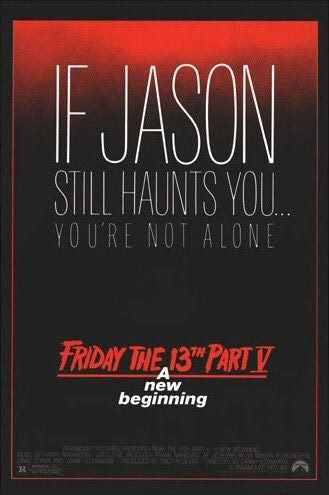

 This wouldn't be the first time New Line purchased the rights to an apparently moribund horror movie franchise. In 1990 the studio had attempted to restart the inert
This wouldn't be the first time New Line purchased the rights to an apparently moribund horror movie franchise. In 1990 the studio had attempted to restart the inert 
 For it’s opening sequence alone the 9th
For it’s opening sequence alone the 9th 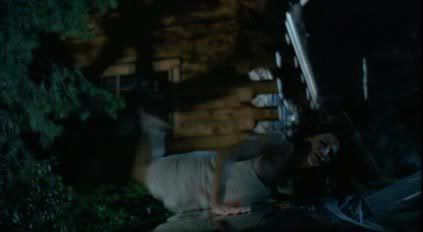
 In Jack Sholder's
In Jack Sholder's 